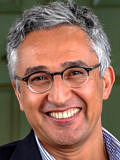C01 – One-dimensional photon-mediated cooperativity of quantum emitters
 Summary
Summary
We aim to realize a cooperative solid-state platform, where a controlled number of quantum emitters are coupled to a single mode of a one-dimensional subwavelength waveguide (nanoguide). This novel coupling mechanism yields a particular form of “polaritonic” quantum cooperative behavior, i.e., a series of rich superposition states of light and matter, whereby delocalized and localized effects can be observed, depending on the emitter spacings and density. Our long-term vision is to realize and explore novel quantum states of light and matter which are mediated by long-range photonic interaction and do not exist in nature.
Project Leaders
Vahid Sandoghdar
Project leader C01
91058 Erlangen
Max Planck Institut für die Physik des Lichts
91058 Erlangen
- Phone number: +49 9131 7133300
- Email: vahid.sandoghdar@mpl.mpg.de
Publications
2023
- , , , , , , :
Quantum Efficiency of Single Dibenzoterrylene Molecules in p-Dichlorobenzene at Cryogenic Temperatures
In: Journal of Physical Chemistry B 127 (2023), p. 5353-5359
ISSN: 1520-6106
DOI: 10.1021/acs.jpcb.3c01755

